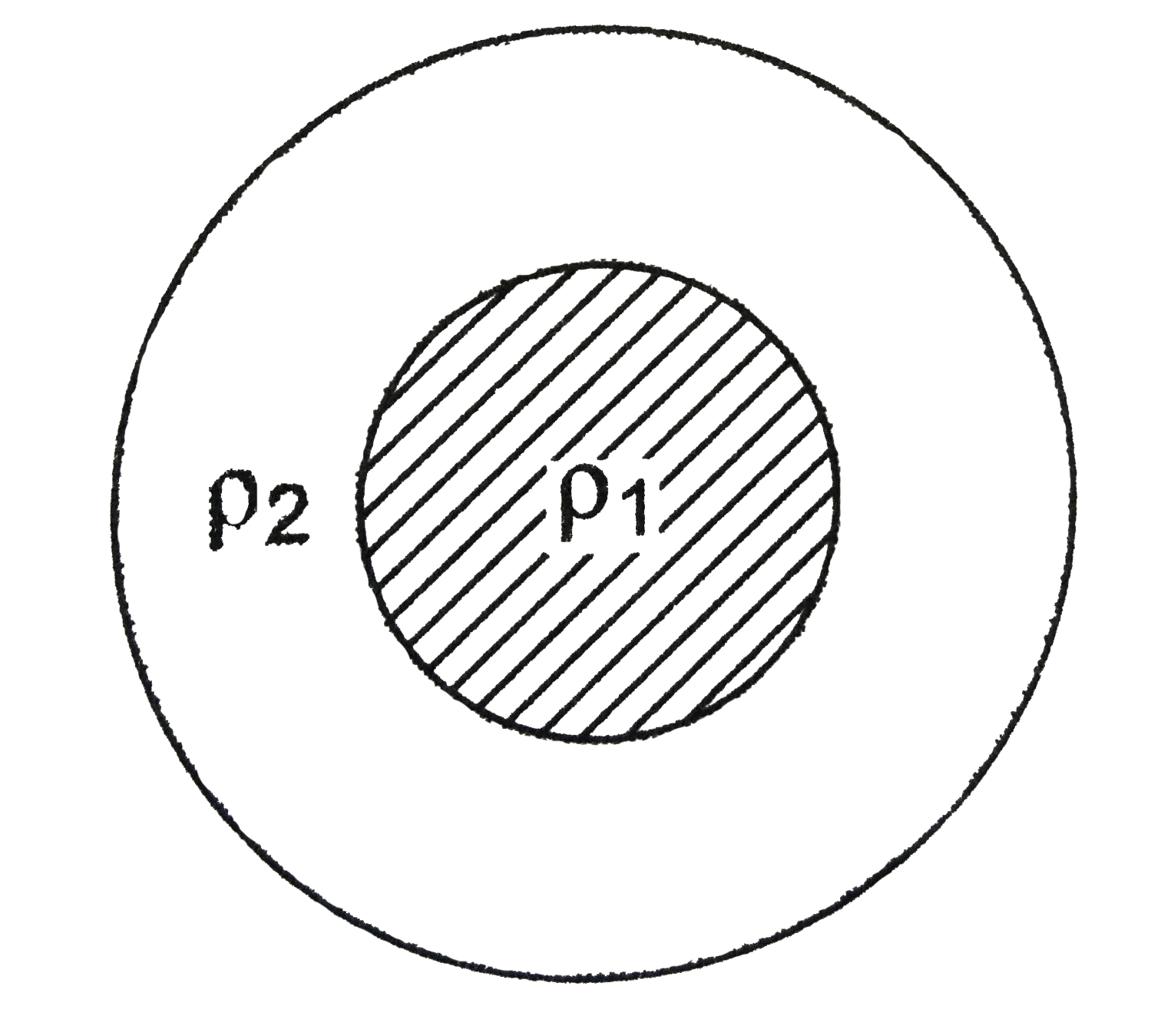Ratio of escape speeds from the surfaces of two uniformly uniformly dense planet of densities ρ and 2ρ respectively having equal radii is
1√2
12
1
2
To solve the problem of finding the ratio of escape speeds from the surfaces of two uniformly dense planets with densities ρ and 2ρ respectively, we can follow these steps:
Step 1: Understand the formula for escape speed
The escape speed ve from the surface of a planet is given by the formula:
ve=√2gR
where g is the acceleration due to gravity at the surface of the planet and R is the radius of the planet.
Step 2: Relate acceleration due to gravity to density
The acceleration due to gravity g can be expressed in terms of the mass M and radius R of the planet:
g=GMR2
where G is the universal gravitational constant.
Step 3: Express mass in terms of density
The mass M of a planet can be expressed in terms of its density ρ and volume V:
M=ρV
For a spherical planet, the volume V is given by:
V=43πR3
Thus, we can write:
M=ρ(43πR3)
Step 4: Substitute mass into the equation for g
Substituting the expression for M into the equation for g:
g=G(ρ43πR3)R2=43πGρR
Step 5: Substitute g into the escape speed formula
Now, substituting this expression for g back into the escape speed formula:
ve=√2gR=√2(43πGρR)R=√83πGρR2
Step 6: Calculate escape speeds for both planets
Let ve1 be the escape speed for the planet with density ρ:
ve1=√83πGρR2
Let ve2 be the escape speed for the planet with density 2ρ:
ve2=√83πG(2ρ)R2=√163πGρR2
Step 7: Find the ratio of escape speeds
Now, we can find the ratio of the escape speeds:
ve1ve2=√83πGρR2√163πGρR2=√8√16=2√24=1√2
Final Result
Thus, the ratio of escape speeds from the surfaces of the two planets is:
ve1ve2=1:√2
The escape speed ve from the surface of a planet is given by the formula:
ve=√2gR
where g is the acceleration due to gravity at the surface of the planet and R is the radius of the planet.
The acceleration due to gravity g can be expressed in terms of the mass M and radius R of the planet:
g=GMR2
where G is the universal gravitational constant.
The mass M of a planet can be expressed in terms of its density ρ and volume V:
M=ρV
For a spherical planet, the volume V is given by:
V=43πR3
Thus, we can write:
M=ρ(43πR3)
Substituting the expression for M into the equation for g:
g=G(ρ43πR3)R2=43πGρR
Now, substituting this expression for g back into the escape speed formula:
ve=√2gR=√2(43πGρR)R=√83πGρR2
Let ve1 be the escape speed for the planet with density ρ:
ve1=√83πGρR2
Let ve2 be the escape speed for the planet with density 2ρ:
ve2=√83πG(2ρ)R2=√163πGρR2
Now, we can find the ratio of the escape speeds:
ve1ve2=√83πGρR2√163πGρR2=√8√16=2√24=1√2
Thus, the ratio of escape speeds from the surfaces of the two planets is:
ve1ve2=1:√2
Similar Questions
Two spheres A and B of equal radii R, each are uniformly dense with densities 2ρ and rho respectively are placed as shown in figure.The initial acceleration of particle placed at point P due to gravity of both the spheres will be (P is just above the surface of sphere B).
View SolutionA solid sphere having volume V and density ρ floats at the interface of two immiscible liquids of densites ρ1 and ρ2 respectively. If ρ1<ρ<ρ2, then the ratio of volume of the parts of the sphere in upper and lower liquid is
View Solution
Knowledge Check
The density of the core a planet is ρ1 and that of the outer shell is ρ2. The radii of the core and that of the planet are R and 2R respectively. The acceleration due to gravity at the surface of the planet is same as at a depth R. Find the ratio of ρ1ρ2
 A2.3B4.5C3.2D5.4
A2.3B4.5C3.2D5.4
If two liquids of same mass but densities ρ1 and ρ2 respectively are mixed, then the density of the mixture is:
View SolutionPertaining to two planets, the ratio of escape velocities from respective surfaces is 1:2 , the ratio of the time period of the same simple pendulum at their respective surfaces is 2:1 (in same order). Then the ratio of their average densities is
View SolutionFind the relation between the gravitational field on the surface of two planets A and B of masses mA,mB and radii RA and RB,respectively if
a. they have equal mass.
b. they have equal (uniform)density.
View SolutionTwo non-conducting solid spheres of radii R and 2R, having uniform volume charge densities ρ1 and ρ2 respectively, touch each other. The net electric field at a distance 2R from the centre of the smaller sphere, along the line joining the centres of the spheres, is zero. The ratio ρ1ρ2 can be
View SolutionFig shows the same block of wood floating in three different liquids A,B and C of densities ρ1,ρ2 and ρ3 respectively. Which liquid has the highest density? Give reason for your answer.

View SolutionThe density of the core a planet is ρ1 and that of the outer shell is ρ2. The radii of the core and that of the planet are R and 2R respectively. The acceleration due to gravity at the surface of the planet is same as at a depth R. Find the ratio of ρ1ρ2

View SolutionThe density of the core a planet is ρ1 and that of the outer shell is ρ2. The radii of the core and that of the planet are R and 2R respectively. The acceleration due to gravity at the surface of the planet is same as at a depth R. Find the radio of ρ1ρ2

View Solution
